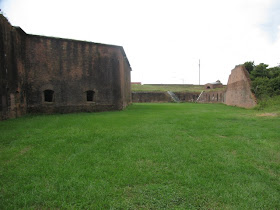Downtown Mobile has Fort
Conde. Demolished in 1923, it was rebuilt with 1/3 of the original fort structure at 4/5 scale in 1976 as part of Mobile's Bicentennial celebration.
 |
| This was the visitor center and gift shop. I don't think this was part of the original fort. |
 |
| Fort Conde as it appears today. |
 |
| Inside the museum they had a lot of history on Mardi Gras. Mobile claims to be the first city in the U.S. to celebrate Mardi Gras. |
Although celebrated prior to the civil war, Mardi Gras was popularized after the war by Joe Cain, a citizen who drove his wagon down main street in celebration of Mardi Gras. Today Mardi Gras is celebrated for several weeks, with several large parades, the biggest on the Sunday prior to Fat Tuesday.
Fort Conde was originally built on this site in 1723 by the French, who originally settled Mobile. The original settlement, in 1702, was located up the bay. In 1711 the settlement moved to its present location and a wooden fort was built and named Fort Louis after French's King Louis XIV. In 1723 they rebuilt the fort using bricks and renamed it Fort Conde after the King's brother-in-law.
From 1763-1780 the English ruled Mobile and the fort was renamed to Fort Charlotte.
The Spanish took over from 1780-1813 and the fort was named Fort Carlotta.
In 1813, the U.S. took over and the fort was named again Fort Charlotte. But around 1820 it was determined there was no longer any use for the fort and it was demolished.
 |
| Another fort in the area was Fort Morgan, located on Gulf Shore at the entrance of the bay to Mobile. This fort was built in 1833. It was under siege in August 1864, one of the later battles in the civil war. |
 |
| This is actually part of Battery Duportail, an addition built in 1899. Down in the hollow was mounted a 12 inch rifled fun which could shoot over 8 1/2 miles. |













Are you staying East forever?
ReplyDeleteAlmost forever. I'll be out in Arizona in December.
ReplyDeleteHi LadyNomad,
ReplyDeleteThanks for leaving a comment in my post Backup and restore blog with export/import. I have responded to your comment.